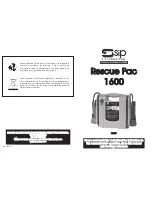
5
Read and understand the entire
contents of this manual before attempting set-
up or operation! Failure to comply may cause
serious injury.
5.0
Setup
Remove all crating and check for shipping damage.
Report any damage immediately to your distributor
and shipping agent. Do not discard any shipping
material until Pipe Notcher is set up and operating
properly.
Use hoist, forklift, or similar means to raise Pipe
Notcher using lifting ring on top. Straps and chains
must be properly rated for weight of Notcher.
The Pipe Notcher can be used in horizontal or
vertical position. Mount it to a stable surface with
appropriate fasteners (not provided). Make sure to
leave space around machine for pipe movement
and general maintenance.
Remove any protectant from the machine with a soft
cloth and a cleaner-degreaser or kerosene. Do not
allow solvents to contact painted or plastic areas.
6.0
Electrical connections
Electrical connections must be
made by a qualified electrician in compliance
with all relevant codes. This machine must be
properly grounded to help prevent electrical
shock and possible fatal injury.
The ESN-40 Pipe Notcher is ready to run at 230-volt
operation. This tool is intended for use on a circuit
that has an outlet that looks like the one illustrated
in Figure 6-1. The tool is intended for use with a
grounding plug that looks like the plug illustrated in
Figure 6-1. Make sure the tool is connected to an
outlet having the same configuration as the plug. No
adapter is available or should be used with this tool.
If the tool must be reconnected for use on a different
type of electric circuit, the reconnection should be
made by qualified service personnel; and after
reconnection, the tool should comply with all local
codes and ordinances.
Before connecting to power source, be sure switch
is in
off
position.
It is recommended that the Pipe Notcher be
connected to a dedicated 15 amp circuit with a
circuit breaker or fuse. If connected to a circuit
protected by fuses, use time delay fuse marked “D”.
NOTE: Local codes take precedence over
recommendations.
6.1
GROUNDING INSTRUCTIONS
This tool must be grounded. In the event of a
malfunction or breakdown, grounding provides a
path of least resistance for electric current to reduce
the risk of electric shock. This tool is equipped with
an electric cord having an equipment-grounding
conductor and a grounding plug. The plug must be
inserted into an appropriate outlet that is properly
installed and grounded in accordance with all local
codes and ordinances.
Improper connection of the
equipment-grounding conductor can result in a
risk of electric shock. Check with a qualified
electrician or service person if you are in doubt
as to whether the outlet is properly grounded.
Do not modify the plug provided with the tool –
if it will not fit the outlet, have a proper outlet
installed by a qualified electrician.
The conductor with insulation having an outer
surface that is green with or without yellow stripes is
the equipment-grounding conductor. If repair or
replacement of the electric cord or plug is
necessary, do not connect the equipment-grounding
conductor to a live terminal.
Use only 3-wire extension cords that have 3-prong
grounding plugs and 3-pole receptacles that accept
the tool's plug.
Repair or replace damaged or worn cord
immediately.
Figure 6-1: grounding
6.2
Extension cords
The use of extension cords is discouraged; try to
position equipment within reach of the power
source. If an extension cord becomes necessary, be
sure it is heavy enough to carry the current your
product will draw. An undersized cord will cause a
drop in line voltage resulting in loss of power and
overheating.
Table 1 shows recommended size to use depending
on cord length and nameplate ampere rating. If in
doubt, use the next heavier gauge. The smaller the
gauge number, the heavier the cord.






























